.
3.06.2016 / 7.00 MESZ
Flash of Light, Loud Boom Over Phoenix Skies Likely a Meteor
An expert in meteorites says a bright flashing light and loud boom over the skies in metro Phoenix looks like a single meteor burning up as it entered the Earth's atmosphere at thousands of miles per hour.
Radar footage shows that meteorites — black rocks ranging in size from a pea to a grapefruit — may have fallen to the ground early Thursday near the eastern Arizona community of Cibecue, said Laurence Garvie, curator of the Center for Meteorite Studies at Arizona State University.
"That's what everyone will rush out there to look at," Garvie said.
Garvie said the flashing light across the sky likely wasn't a meteor shower, but rather a random piece of space rock that intersected with the orbit of the Earth.
Video footage shows the skies went from dark to instantly bright — and then grew even brighter.
It produced a loud boom that awoke people who were sleeping.
The flash in the sky finally decreased in intensity and fizzled out.
Vicky Schmid of Snowflake, Arizona, said she was asleep in bed when she and her dogs were awoken by a loud noise.
"I thought somebody was breaking into the house," she said.
She checked her front door camera from an app on her phone and saw video showing an intense burst of light flashing across the sky.
"The funny thing was the (video) clip said that at 3:56 a.m. a visitor was detected," she said.
Quelle: abcNews
...
Update: 13.15 MESZ
-

Fireball Lights Pre-Dawn Sky over Arizona
This feature was updated at 9:00 p.m. EDT to reflect new data on the size, mass and kinetic energy of the fireball.
For a few seconds early Thursday, night turned into day as an extremely bright fireball lit the pre-dawn sky over much of Arizona, blinding all-sky meteor cameras as far away as western New Mexico.
Based on the latest data, a small asteroid estimated at 5 feet (1-2 meters) in diameter - with a mass of a few tons and a kinetic energy of approximately half a kiloton - entered Earth's atmosphere above Arizona just before 4 a.m. local (MST) time. NASA estimates that the asteroid was moving at about 40,200 miles per hour (64,700 kilometers per hour).
Eyewitness reports placed the object at an altitude of 57 miles above the Tonto National Forest east of the town of Payson, moving almost due south. It was last seen at an altitude of 22 miles above that same forest.
“There are no reports of any damage or injuries—just a lot of light and few sonic booms,” said Bill Cooke in NASA's Meteoroid Environment Office at the Marshall Space Flight Center in Huntsville, Alabama. “If Doppler radar is any indication, there are almost certainly meteorites scattered on the ground north of Tucson.”
The NASA Meteoroid Environments Office (MEO) monitors the small rock (meteoroid) environment near Earth in order to assess the risks posed to spacecraft by these bits of tiny space debris. As part of this effort, it operates a network of meteor cameras within the U.S. that are capable of detecting meteors brighter than the planet Jupiter. Three of these cameras are in southern Arizona.
Cooke notes that he and other meteor experts are having difficulty obtaining data on the June 2 fireball from meteor camera videos, since many of the cameras were almost completely saturated by the bright event.
Meteoroid impacts are a continuously occurring natural process. Every day, about 80 to 100 tons of material falls upon the Earth from space in the form of dust and meteorites. Over the past 20 years, U.S. government sensors have detected nearly 600 small asteroids, a few meters in size, which have entered the Earth’s atmosphere and created spectacular bolides. The superbolide that impacted over Chelyabinsk, Russia in 2013 is estimated to have been 65 feet (20 meters) in size and released over 800 times the energy of the Arizona fireball. Impacts of that size take place a few times a century, and impacts of larger asteroids are expected to be far less frequent (on the scale of centuries to millennia) but can happen on any day.
NASA’s Planetary Defense Coordination Office is responsible for finding, tracking, and characterizing near-Earth asteroids, identifying potentially hazardous objects, and planning for the mitigation of potential impacts to Earth that could do damage at ground level. More than 14,000 near-Earth asteroids (NEAs) have been discovered since NASA-sponsored efforts began in 1998 to detect, track and catalogue asteroids and comets.
.
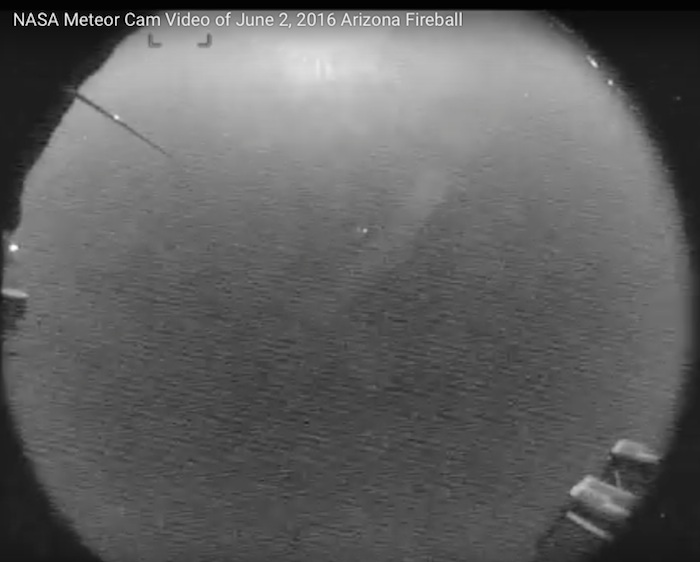
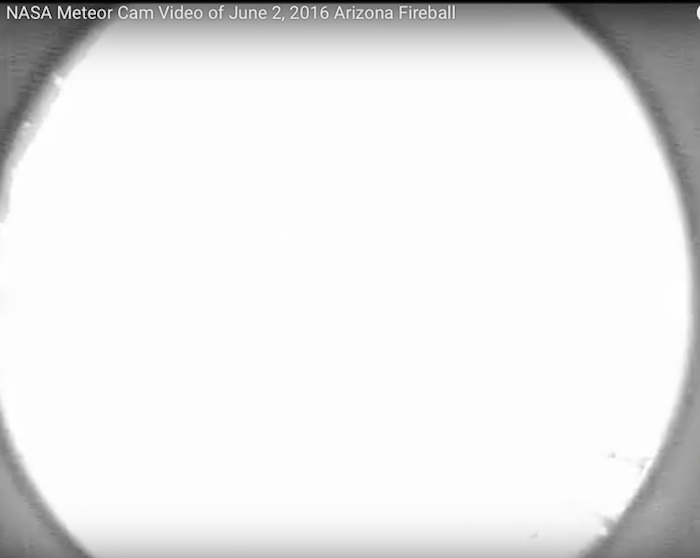
Video obtained from the NASA meteor camera situated at the MMT Observatory on the site of the Fred Lawrence Whipple Observatory, located on Mount Hopkins, Arizona, in the Santa Rita Mountains.
Credits: NASA/MEO
-


This footage from the Sedona Red Rock Cam (part of the EarthCam network) shows how brightly the ground was illuminated during the fireball, which entered the atmosphere over Arizona shortly before 4 a.m. MST on June 2, 2016.
Credits: Sedona Red Rock Cam/EarthCam
Quelle: NASA


---
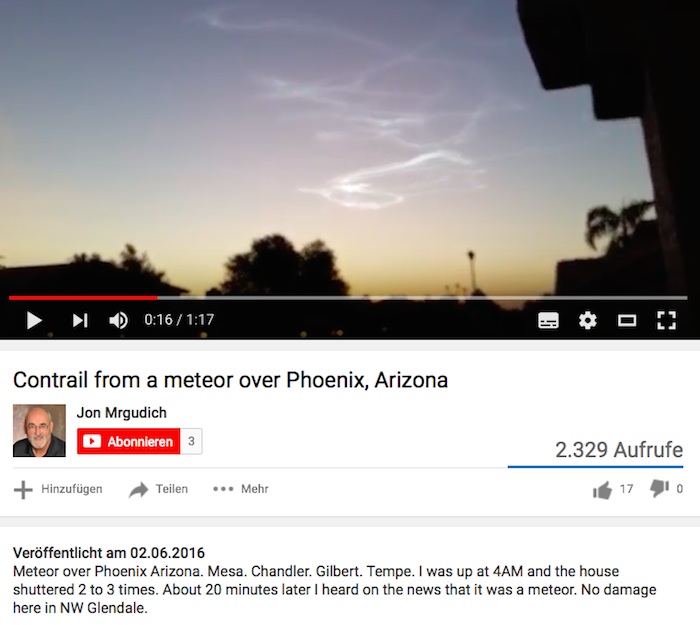

Quelle: YouTube
-
Update: 20.45 MESZ
.
Meteorit erhellt den Nachthimmel
Am Donnerstag sorgte ein heller Feuerball über dem amerikanischen Bundesstaat Arizona für Aufregung.

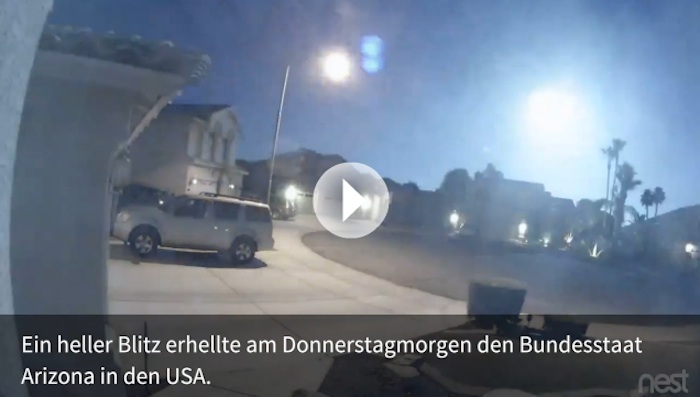

Faszinierendes Naturschauspiel: Der Kleinplanet über dem Nachthimmel Arizonas.
Donnerstagnacht erhellte ein Meteorit den Nachthimmel über dem amerikanischen Bundesstaat Arizona. Laut der Nasa handelte es sich dabei um einen Kleinplaneten, der 1–2 Meter gross und ein Paar Tonnen schwer gewesen sei. Dieser hatte sich mit 64'000 km/h auf die Erdoberfläche zubewegt.
Es gebe keinen Hinweis auf Beschädigungen oder Verletzte, verlautete die Nasa in einer Mitteilung. Mehrere Zeugen hätten aber von einem lauten Knall berichtet. Das Expertenteam der Nasa hatte Probleme, Genaueres über den Meteoriten herauszufinden, da viele der Spezialkameras zu sehr vom entstandenen Licht geblendet wurden.
Meteoriteneinschläge sind ein natürliches Vorkommen. Jeden Tag fallen etwa 80 bis 100 Tonnen Weltraummaterie auf die Erde. In den letzten 20 Jahren wurden fast 600 kleine Asteroiden verzeichnet.
Quelle: Basler Zeitung
(Anmerkung: Kleinplanet-Bezeichnung von Redaktion: Basler Zeitung)
.
Update: 21.30 MESZ
ASTEROID EXPLODES OVER ARIZONA: On June 2nd just before 4 a.m. MST, a small asteroid hit Earth's atmosphere and exploded over Arizona. The airburst shook the ground below and produced a flash of light 10x brighter than a full Moon. NASA says it was a 3-meter wide space rock from beyond the orbit of Mars. Shortly after the explosion, Mike Lerch walked out the front door of his house in Phoenix on the way to work, and this is what he saw:
.
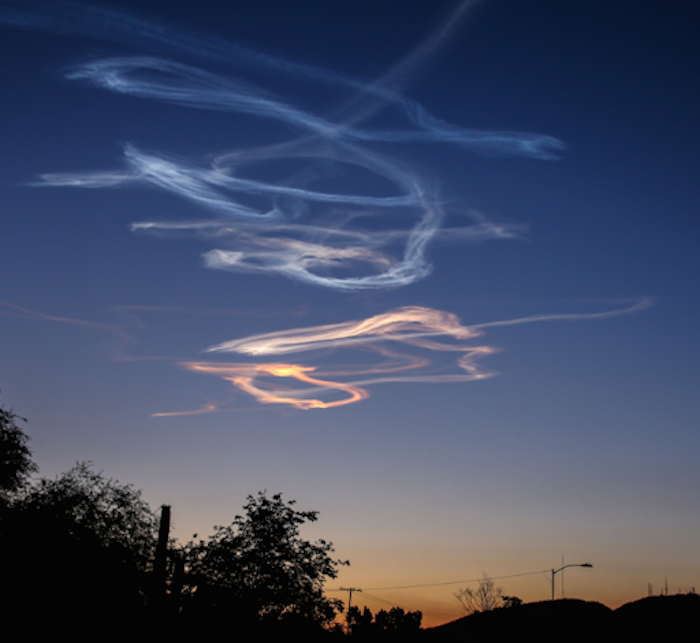
"At first I thought it was a rocket launch," says Lerch. "Now I realize it was debris from the asteroid." Indeed, the smokey remains were widely visible as they twisted in the winds high above Arizona.
The flash itself was so bright, it briefly turned night into day. Marsha Adams sends these before, during, and after shots from Sedona, Arizona:
.

"The camera was facing NE so it did not record the asteroid itself," says Adams. "However, the flash cast very distinct shadows, and landscape colors were vivid."
Bill Cooke of NASA's Meteoroid Environment Office says this is the brightest fireball detected in the 8-year history of the NASA's All Sky Fireball Network, an array of cameras that monitors fireball activity across the USA. The fact that the explosion blinded most cameras that saw it initially complicated analysts' efforts to pinpoint its nature and origin. Ultimately, however, they were able to draw firm conclusions: The mass of the asteroid was some tens of tons and it exploded with a kinetic energy of approximately 10 kilotons.
"There are no reports of any damage or injuries—just a lot of light and few sonic booms," says Cooke. "If Doppler radar is any indication, there are almost certainly meteorites scattered on the ground north of Tucson."
Quelle: Spaceweather
-
Update: 4.06.2016
.
After the asteroid breakup, the hunt begins for the pieces
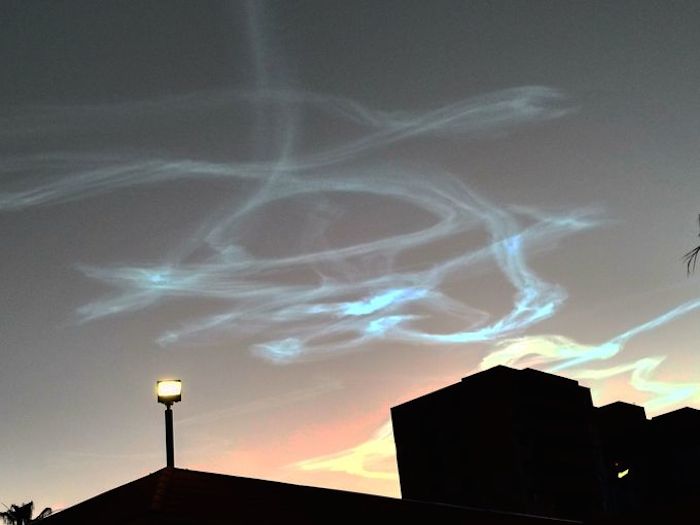


For a few fleeting seconds about 3:57 a.m. Thursday, the Arizona sky lit up with a bright flash and loud boom as an asteroid broke apart over Payson. The event could land the Center for Meteorite Studies at Arizona State University its "winning lottery ticket," or so its curator hopes.
The center, with what it calls the world's largest university meteorite collection, hopes to be chosen as the institution that gets to analyze and study any recovered pieces from the meteorite that may be found, said Laurence Garvie, the center's curator, on Friday.
Over the past century, pieces from only three meteorites have been recovered in the state, Garvie said.
The first meteorite recovery in Arizona took place in 1912, the second in 1998 and the third in 2009, he said.
This year, Garvie said, pieces from only two meteorites have been recovered in the United States as a whole, one in Florida and one in northern Texas. In 2015, there was only one recovery, in California.
Garvie compared the possibility of being chosen to analyze the recovered meteorite pieces to winning a big lottery drawing among all scientists.
"Yesterday the lottery has been drawn and now they (explorers for the fallen pieces) are going to go out and see who won," Garvie said.
.


A security system in Arizona caught a brilliant flash of light from an asteroid burning up in the atmosphere. Video Credit: Susanne Campbell-Vincent
.
Amateurs fan out to find fragments
According to Garvie, most meteorites are hunted by amateurs who have the ability to leave immediately for the landing areas and explore for the pieces.
Once pieces have been recovered, the fragments then will be taken to a scientist or organization of the collectors' choice.
"I would hope they will take it to ASU and come to me to do the analysis, but they can go to any other scientist in the U.S," Garvie said.
There is no guarantee that recovery teams will be able to locate the fallen fragments, he said. But some people familiar with the process don't believe it will be exceptionally difficult.
The freshly fallen meteorite broke apart over the eastern part of the state, where the majority of the rocks are red or brown.
The recovery teams will be looking for black, rounded pieces that will stand out against the native rock, Garvie said.
Doppler radar is also expected to help in the discovery, he said, as it should be able to pinpoint approximately where the meteorite shards may have fallen.
A collection of other-worldly objects
The center at ASU has a growing display of rocks and meteorites from all over, including a piece from the meteorite in northern Texas that center officials plan to add to the exhibit very soon, Garvie said.
“Something like this is exciting for both the collectors and scientists. The pieces could be from Mars, the Asteroid Belt or from the moon.”
Laurence Garvie
The university's collection has more than 1,600 samples of different meteorites. The rocks are preserved and displayed for scientific research and education.
The center's display, which is open to the public, is in the Interdisciplinary Science and Technology Building on the university's Tempe campus.
Garvie said that while the most recent recoveries have been identified as ordinary chondrites, pieces from one of the most common classes of meteorites, these findings can't be described as anything but extraordinary. Because they aren't of this earth.
"Something like this is exciting for both the collectors and scientists," Garvie said. "The pieces could be from Mars, the Asteroid Belt or from the moon."
Asteroid vs. meteor: What's the difference?
Livescience.com explains many of the details on its website, as does the American Meteor Society. Here are some of the extraterrestrial basics from those two sources:
Asteroid: An asteroid is a rocky object in space that's smaller than a planet. There are millions of asteroids orbiting the sun, some 750,000 of which are found in the Asteroid Belt, a vast ring of asteroids between the orbits of Mars and Jupiter.
Meteoroid: A general term describing small particles of comets or asteroids that are in orbit around the sun. There's no universally accepted definition (based on size or any other characteristic) that distinguishes a meteoroid from an asteroid — they're simply smaller than asteroids. If remnants of the parent meteoroid survive the trip through the atmosphere to reach the ground, then these remnants are called meteorites.
Meteor: A meteor is an asteroid or meteoroid or other object that burns and vaporizes upon entry into the Earth's atmosphere; meteors are commonly known as "shooting stars." Whenever a meteoroid plows into the Earth’s atmosphere, it will create a brief flash of moving light in the sky.
Meteorite: If a meteor survives the plunge through the atmosphere and lands on the Earth's surface, it's known as a meteorite.
Fireball: A fireball is another term for a very bright meteor, generally brighter than magnitude -4, which is about the same magnitude of the planet Venus in the morning or evening sky.
Quelle: az central
7749 Views
